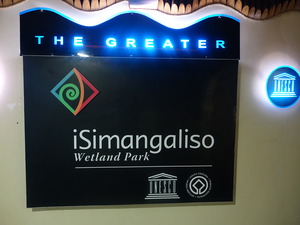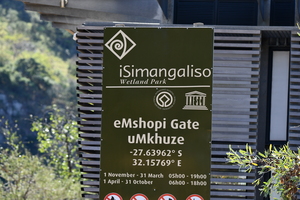iSimangaliso Wetland Park

iSimangaliso Wetland Park covers five interlinked ecosystems along a 220km stretch of coast, including Lake St. Lucia.
It includes marine areas the Indian Ocean, sandy beaches, dunes, wetlands, forests, lakes and savannah. Lake St. Lucia has a shifting salinity due to varying climatic cycles. Notable wildlife includes nesting turtles, whales, dolphins, whale sharks and waterfowl.
Community Perspective: it’s a huge park with several completely different ecosystems. It can be easily explored on your own self-driving from the city of St. Lucia, with Cape Vidal most recommended for the views. The area is touristy and its specific water-related values are often overlooked in favour of the reintroduced Big 5 fauna.
Map of iSimangaliso Wetland Park
Community Reviews
Traveling Girl

My visit to the iSimangaliso Wetland Park in the St. Lucia area was in February 2020. This is summer and off peak for tourism. We were a party of 3, and self driving. The small town of St. Lucia was tourist friendly, affordable, and easy to navigate. We had come from the Drakensburg area, so it was a long drive to St Lucia, but the roads are good and this posed no challenges. We had one experience of being overcharged for snack items at a gas station.
The wetlands park covers a large area, and we visited the region over a course of 3 days. The first visit was on the Hippo tour boat. This was easy to book via our BnB host and pay with a credit card. The boat tour people picked us up at our BnB and took us to the boat launch area. The launch area was through a former industrial area, but we were on the water quickly and uneventfully. Immediately, we paused to enjoy colorful yellow weavers building nests. The flock was large and appeared to be thriving. After the photos were taken, we headed upstream to the first pod of hippos. The hippo pod was of perhaps 20-25 visible members, and the captain maneuvered the boat very close for many photo ops. The second pod was about the same size- 20 or so individuals visible-- and at that juncture one more boat was on site. We also saw a few eagles, egrets, and other birds, but the hippos were the main attraction and did not disappoint. Yes, it's touristy, but we were fortunate to have the water to ourselves most of the time, and the close up views of hippos are unattainable elsewhere.
Our second day included a drive to the beach and sand dunes, as well as a beach horseback ride. The beach offered lovely panoramic views but the weather was too windy for a dip in the sea. It's off season for the whale migration. The parking lots are full of vendors, so beware the idle glance towards their wares or the random charge for parking. There are a variety of invasive plant species, including goat head stickers, which necessitated shoes until the sand areas are reached. Walk barefoot at your own risk!
The last day was a drive through the park towards Cape Vidal to enjoy the scenery and wildlife. The scenery was lovely, and the ecosystem tiers were obvious. We did see wildlife, including lots of monkeys, some warthogs, cape bison, kudu, zebra and impala. Binoculars aided tremendously. Overall, though, the wildlife sightings were sparse for such a large park that has reintroduced large fauna more than a decade ago. I would expect a more teeming ecosystem, given the circumstances and the protections that such a large park would provide.
Els Slots

iSimangaliso Wetland Park lies well on the main tourist trail around South Africa. It’s a huge park, stretching for 220km along the Indian Ocean coast until the border with Mozambique. It also has a 5 km wide marine component along the whole coastline. I stayed for 3 nights in the town of St. Lucia, which is the tourist capital and the main access point to the park.
Because of its size, there are completely different ecosystems to be enjoyed. For the marine part, I had set my eyes on a whale-watching tour. But unfortunately, it was cancelled due to strong winds. So what I mainly did was drive around by myself. From St. Lucia there are two gates into the park, one to the Eastern Shores and one to the Western. The park is remarkable for South African standards as it is very green. No shortage of rain here, compared to the severe drought much of the rest of the country suffers from.
On my first morning, I entered via Bhangazi Gate, which leads you to the Eastern Shores ending at Cape Vidal. For the best part, the drive goes through a savannah. Prominent inhabitants are the Greater Kudu (quite big indeed) and other cloven-hoofed mammals such as the Common Reedbuck. All loop roads from the main road were closed for maintenance, but the various viewpoints were accessible. They will give you views over the coastline, one that is remarkably similar to the all-too-familiar Wadden Sea.
This road ends at a wooded area, where two species of monkeys play around. The Vervet Monkeys occupied their usual spot at the parking area, looking for any leftover food from human beings visiting the beach there. More special are the Samango Monkeys, who kept their distance. They’re a subspecies of the Blue (or Sykes') Monkey.
On the way back I stopped at the Catalina Bay lookout, probably the best view of this side of the park. It overlooks Lake St. Lucia.
Later that day at 4 pm I took part in the most touristy thing you can do here: a Hippo & Croc Boat Tour. I was already skeptical beforehand, but it’s the only way to see some of the park from the water. The boat travels the estuarine system into Lake St. Lucia. There are many operators offering this tour, and they all visit the same spots at the same time (so you have to wait your turn at each stop). Imagination and variation are not strong points of the South African travel industry in general – they cater to the mainstream, to the first-time visitor to Africa. The boat slowly navigated the estuary, hitting the favourite spots of the hippos. Sightings of these are abundant, and as always they are fun to watch. We didn’t see anything else of interest, besides two almost hidden crocodiles and a fish eagle.
The next day I entered the park at the Dukukduku (western) gate. This part seems to have more mammals than the one I visited the day before. The road was blocked by a large male elephant so I had to wait a while until he finished his breakfast. There are also large herds of wildebeest here, as well as zebra, giraffe and various antelopes. The scenery isn’t as attractive as the Eastern Shores. During the evening I took a night drive tour, also into this western part. As it was raining slightly, we got very cold. The only remarkable creature of the night we saw was a Bushbaby.
iSimangaliso nowadays advertises itself as a Big 5-park (or even a Big 7). I find that a pity, as its unique setting for Southern Africa and water-related features should be their main selling point. These features are now difficult to enjoy. I did see a few birds, for example, I think the site could do with some good bird hides. South African parks are obsessed with the Big 5, and they reintroduce species frequently to reach the 5 (iSimangaliso got lions again in the last few years). This seems to be not only the policy of the main parks managed by the SAN, but also that of the many private game (and hunting!) reserves the country has. In Mapungubwe I was staying in one of those, and the staff told me that they just bought some elephants and were already planning for adding rhinos.
Read more from Els Slots here.
Anita
I visited the Sodwana area, that is linked to the iSimangaliso Wetland Park, for the first time this past December as a diving vacation.
Although the diving was great I have to admit that the experience was tainted by reports of racism and hard-handed treatment of guests to the park by park official - specifically on New Year's day. There are apparently some video evidence of the teargassing of a family trying to leave the park on the 1st of January and I hope that the owner will also publish that.
The mess that greeted us on the 2nd of January, when we wanted to dive again, was also not becoming of a World Heritage site. Despite a "No Alcohol" rule on the beach, the road to the park, as well as the beach was littered with empty bottles and other rubbish. This only finally cleared after about 2 days.
This is such a sad state of affairs, since the area is really great and the reef is great for diving! Hopefully enough people will make their voices heard to force some kind of action on this.
André Dique
The St. Lucia estuary is one of the unique biosystems on this planet, with the subtle interplay between marine and terrestrial aquatic life. This is the only place where I've seen sharks swimming in the lagoon next to hippopotamuses, and crocodiles swimming in the sea!
There are many beautiful woodland paths to explore and the warm Indian Ocean is great for swimming. This is also the only place where I've seen a barracuda jumping over the surf, from the shore! There is an abundance of fauna and flora to admire in the protected areas as well.
The cheapest way to stay is on one of the camping grounds, although there is luxury accommodation as well. Public transport is poor so it is recommended that you make your own arrangements to get around.
Community Rating
- : SirLoydd Seadie Aj.daamen Rachel Perkins Jay T
- : Zoë Sheng Tamara Ratz
- : Joyce van Soest Richardleesa Csaba Nováczky Milan Jirasek Clem C Traveling Girl
- : Gary Arndt Christoph Randi Thomsen Javier Bernard Joseph Esposo Guerrero
- : Thomas van der Walt Philipp Leu Richard Stone Svein Elias Mihai Dascalu Eric PK Ralf Regele Els Slots
- : Szucs Tamas Solivagant
Site Info
- Full Name
- iSimangaliso Wetland Park
- Unesco ID
- 914
- Country
- South Africa
- Inscribed
- 1999
- Type
- Natural
- Criteria
-
7 9 10
- Categories
- Natural landscape - Rivers, Wetlands and Lakes
- Link
- By ID
Site History
2008 Name change
From "Greater St Lucia Wetland Park" to "iSimangaliso Wetland Park"
1999 Inscribed
Site Links
Unesco Website
Official Website
In the News
Connections
The site has 33 connections
Ecology
Geography
Human Activity
Timeline
WHS Names
WHS on Other Lists
World Heritage Process
Visitors
100 Community Members have visited.

